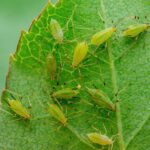Aphid
Leaf Feeding Insects & Mites
Aphids are small, sap-sucking insects that belong to the family Aphididae. They are commonly found on the new growth and leaves of plants, and their feeding can cause wilting, curling, yellowing, and stunted growth of leaves. Some species of aphids also excrete honeydew, which can attract ants and provide a breeding ground for sooty mold.
Aphids come in various colors such as green, black, yellow, or brown, and they have a pear-shaped body and long antennae. They reproduce quickly, with females capable of producing offspring without mating. This can lead to rapid population growth and severe infestations.
Aphids can be controlled through natural predators, such as ladybugs, lacewings, and syrphid flies. However, when infestations are severe, chemical treatments may be necessary. It is also important to practice good cultural practices, such as regular cleaning of debris, proper pruning, and providing adequate water and nutrients, to prevent and manage aphid infestations.
In conclusion, aphids are common pests in gardens and landscapes, but with proper management and control techniques, their impact on plants can be minimized. Professional arborists can assist in identifying and treating aphid infestations, as well as providing recommendations for preventative measures to keep plants healthy and aphid-free.






